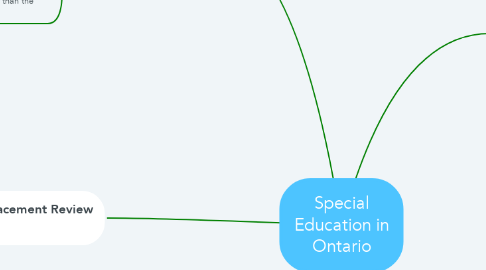
1. General Rationale
1.1. All students deserve access to an education
1.1.1. No student can be denied access to publicly funded education - even those with severe developmental or physical difficulties
1.2. Some students require additional supports to access the curriculum
1.2.1. Students should be given every necessary tool and accommodation to allow them access regular classroom curricula if and when possible
1.3. Schools, students, and society work better when inclusion is the rule rather than the exception
1.3.1. Students should be included in regular classroom settings - integration into classrooms would normalize integration in to regular society as well - which would make both society, and the individual, better as a result
2. Individual Education Plan
2.1. An individual Education Plan must be created for any student with an exceptionality 30 days from the start of a program
2.2. IEPs are a summary of the student's strengths, needs, assessments, accommodations, and modifications
2.2.1. Accommodations allow students to access regular curriculum, often in regular classrooms, with some slight changes to assessment, the environment, or instruction
2.2.2. Modifications change the curriculum, and usually mean students are not working towards standard Ontario credits (in secondary classrooms), and may not receive an OSSD
2.2.3. IEPs will show a student's category of exceptionality, and their placement. This must be informed by relevant assessment data.
3. Identification Placement Review Committee
3.1. Using relevant assessment data, students are placed in a category of Exceptionality
3.2. Some students are not identified as exceptional according to the findings of assessments
3.2.1. These students can still receive an IEP, but their exceptionality would not fit one of the main categories (can be labeled "N/A")
3.2.2. Parents can challenge, in writing, the findings of an IPRC
3.3. Parents/guardians can request an IPRC for their child in writing, and school boards must comply
4. Categories of Exceptionalities
4.1. Behavioural - students have behaviour problems that affect educational performance
4.1.1. Can include Oppositional Defiance Disorder, Anxiety, Compulsive behaviours, etc.
4.2. Communicational
4.2.1. Autism
4.2.2. Deaf/Hard of Hearing
4.2.3. Language Impairment
4.2.3.1. Difficulties in comprehension and/or use of written or spoken language
4.2.4. Speech impairment
4.2.5. Learning Disability
4.2.5.1. Intellectual abilities must be at least "average"
4.3. Intellectual
4.3.1. Giftedness
4.3.2. Mild Intellectual Disability
4.3.2.1. Slow intellectual development, but may profit from regular classrooms with support and/or modifications
4.3.3. Developmental Disability
4.4. Physical
4.4.1. Blind/Low Vision
4.4.2. Physical Disability
4.5. Multiple Exceptionalities
4.5.1. combinations of the above exceptionalities that result in much more support needed
5. Placement Types
5.1. Regular class with indirect support
5.1.1. Student is in a regular class and the teacher receives special consultative services
5.2. Regular class with resource assistance
5.2.1. The student is placed in the regular class for most or all of the day and receives specialized instruction, individually or in a small group, within the regular classroom from a qualified special education teacher.
5.3. Regular class with withdrawal assistance
5.3.1. The student is placed in the regular class and receives instruction outside of the classroom for less than 50 per cent of the school day, from a qualified special education teacher.
5.4. Special education class with partial integration
5.4.1. The student is placed by the IPRC in a special education class where the student-teacher ratio conforms to the standards in O. Reg. 298, section 31, for at least 50 per cent of the school day, but is integrated with a regular class for at least one instructional period daily.
5.5. Special education class full time
5.5.1. The student is placed by the IPRC in a special education class, where the student-teacher ratio conforms to the standards in O. Reg. 298, section 31, for the entire school day.
